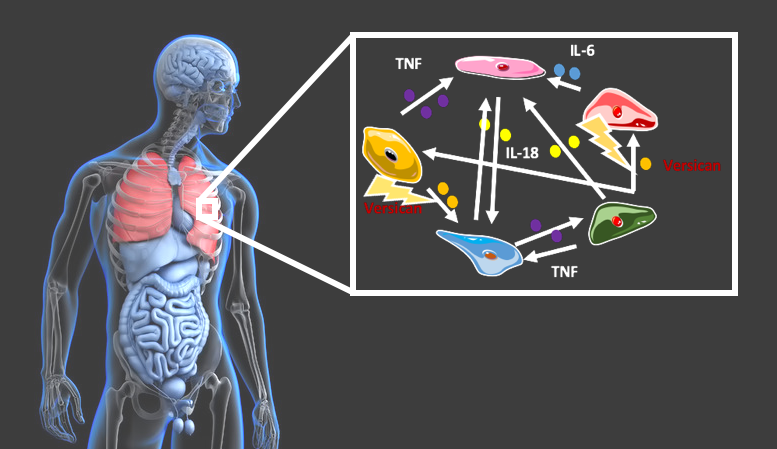
2021/02/16
A new method to find modulators of the immune response to COVID-19
The recent paper, published in Science Advances by the Computational Biology Laboratory at CICbioGUNE, member of the Basque Research & Technology Alliance BRTA and at Luxembourg Centre for Systems Biomedicine (LCSB) in Luxemburg, describes a new method of how molecules can be identified that amplify and maintain the inflammatory response upon an infection
They use their novel method to identify these molecules in COVID-19 patients and suggest new potential targets for therapeutic intervention in severe cases of COVID-19
(Bilbao, 16 February 2021). Upon getting infected for instance by a virus, the human immune system is typically triggered to fight the intruder. The immune response is composed of complex processes and involves various types of cells, which communicate with each other via so-called cytokines.
A major task of the immune system is to identify and remove those cells of the body that got infected which causes inflammation.
“Normally, the immune system is tightly controlled keeping the tissue damage as low as possible,” explains Antonio del Sol group leadr at Computational Biology Laboratory in CIC bioGUNE, “However, in conditions where the pathogenic factor cannot be readily cleared, we know from other infectious diseases that patients could develop a hyperinflammatory condition where the immune response is amplified and maintained by positive feedback loops. This hyperinflammatory condition increases the severity of the symptoms and might even lead to death. The present challenge is how to alleviate inflammation while not lowering the patient’s ability to clear SARS-CoV-2, the virus causing COVID-19”, he continues.
To address this problem, the researchers developed a method by which modulators of the immune response can be identified. Knowing the molecules amplifying the inflammation, their activity could be brought back to innocuous levels.
Analysing more than 1,700 cell-cell interactions, the group created a comprehensive map of the immune response in the lungs of COVID-19 patients with mild and severe symptoms. The special characteristic of this approach is that the genomic information of individual cells was used to create these maps, thus representing also the different cell types of the immune system.
“We decided to use our model in the context of COVID-19 as patients with severe disease courses also often exhibit hyperinflammation putting their life in danger,” Sascha Jung first author of the publication. “We found that the increased inflammation is caused by feedback mechanisms, which also partially impair the immune cells and thus exacerbate the inflammatory response,” he adds.
Del Sol and his team used their model to identify those molecules that might be able to modulate the runaway inflammatory response of the immune system. He summarizes the findings of this approach: “By computational perturbation of genes involved in the feedback loops, we predicted the proteins Versican and the Toll-like Receptor 2 to play a major role. According to our model, an inhibition of either of these molecules can disrupt up to 75% of the feedback loops without interfering with the general immune response.”
The protein Versican resides in the extracellular matrix and is involved in several intercellular communication processes. In turn, the Toll-like Receptor 2 resides at the surface of cells where it detects pathogenic molecules. Both proteins are known to play a role in the human immune response.
The results of this study have already attracted the attention of immunologists at the “Cytokines” conference, the world’s most important conference on basic, translational and clinical research related to cytokine biology, where Del Sol’s work has been presented. According to these novel findings, the predicted proteins constitute a potential target for medical intervention to treat COVID-19, which is currently being evaluated in animal models together with immunologists from the University of Washington, USA.
The full publication can be found here:
About CIC bioGUNE
The Centre for Cooperative Research in Biosciences (CIC bioGUNE), located in the Bizkaia Technology Park, is a biomedical research organisation conducting cutting-edge research at the interface between structural, molecular and cell biology, with a particular focus on generating knowledge on the molecular bases of disease, for use in the development of new diagnostic methods and advanced therapies. CIC bioGUNE has been accredited as a “Severo Ochoa Centre of Excellence”, the highest level of recognition for centres of excellence in Spain.
About BRTA
The BRTA is an alliance made up of 4 collaborative research centres (CIC bioGUNE, CIC nanoGUNE, CIC biomaGUNE y CIC energiGUNE) and 12 technology centres (Azterlan, Azti, Ceit, Cidetec, Gaiker, Ideko, Ikerlan, Lortek, Neiker, Tecnalia, Tekniker y Vicometch), with the aim of developing advanced technological solutions for Basque companies.
With the support of the Basque Government, the SPRI Group and the Provincial Councils of the three regional provinces, the alliance seeks to promote collaboration among its centres, to strengthen the conditions to generate and transfer knowledge to companies, contributing to their competitiveness, and to spread Basque scientific and technological capacity.
BRTA has a staff of 3,500 professionals, accounts for 22% of the Basque Country’s R&D investment, generates an annual turnover of over EUR 300 million and files 100 European and international patents per year.
About Ikerbasque
Ikerbasque - Basque Foundation for Science- is the result of an initiative by the Department of Education of the Basque Government that aims to reinforce the Basque scientific system through the attraction, recovery and retention of researchers from all around the world. Nowadays, It is a consolidated organization with 290 researchers from from all fields of knowledge.
About Luxembourg Centre for Systems Biomedicine
The LCSB is accelerating biomedical research by closing the link between systems biology and medical research. Collaboration between biologists, medical doctors, computer scientists, physicists, engineers and mathematicians is offering new insights in complex systems like cells, organs, and organisms. These insights are essential for understanding principal mechanisms of disease pathogenesis and for developing new tools in diagnostics and therapy.
See a large version of the first picture





